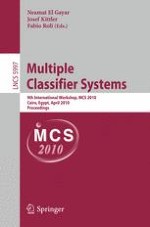2010 | Buch
Multiple Classifier Systems
9th International Workshop, MCS 2010, Cairo, Egypt, April 7-9, 2010. Proceedings
herausgegeben von: Neamat El Gayar, Josef Kittler, Fabio Roli
Verlag: Springer Berlin Heidelberg
Buchreihe : Lecture Notes in Computer Science
